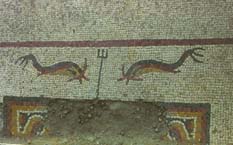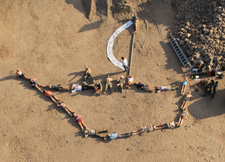Area H

Area H is located on the west side of the mound, between Area F and Area D1. It was opened, in the same manner of area F, with the purpose of investigating the connection between the southern temple and the town. Podium H itself is completely eroded to the sea - its only remaining walls being the southern and eastern ones. Thus, excavation is confined to the area east of the eastern temenos wall.
Excavation
1996 - 2000 by the University of California, Berkeley (dir. Andrew Stewart).
Stratigraphic sequence
Middle Ages
The latest remains in this area date to the Middle Ages and are related to the construction of the fortified tower on the headland to the southwest of the area. A moat, separating that outcrop from the rest of the tell was cut across area H. Some of the robbing of the monumental Roman structures can also be dated to the same period.
Roman Period
 Phases 1-2: As in other areas, two Roman phases were
found. As in area F,
it is the later of the two that the temple podium belongs with. None of the
superstructure for this phase (1) remains. It consists of constructional fills and
a series of foundations/retaining walls associated with the approach to temple H.
Phases 1-2: As in other areas, two Roman phases were
found. As in area F,
it is the later of the two that the temple podium belongs with. None of the
superstructure for this phase (1) remains. It consists of constructional fills and
a series of foundations/retaining walls associated with the approach to temple H.
Buried under the entry-ramp to the temple is the earlier Roman insula, consisting of shops and apparently well-to-do residences. Built on the western slope of the mound, right above the beach, and completely buried by the massive filling operations of the temple podium, their preservation is extraordinary - the western half of the building stands two stores high.
 In one of the rooms of this structure a
mosaic showing dolphins and tridents was found and the adjacent room was decorated with frescos. The walls of these rooms were
dismantled to construct the retaining
walls for the temple, and the fresco was found in thousands of pieces on the floor
and in the basement below. It is, however, possible to tell that at least some of the
frescos were figurative - probably garden scenes similar to ones found in Pompeii.
In one of the rooms of this structure a
mosaic showing dolphins and tridents was found and the adjacent room was decorated with frescos. The walls of these rooms were
dismantled to construct the retaining
walls for the temple, and the fresco was found in thousands of pieces on the floor
and in the basement below. It is, however, possible to tell that at least some of the
frescos were figurative - probably garden scenes similar to ones found in Pompeii.
